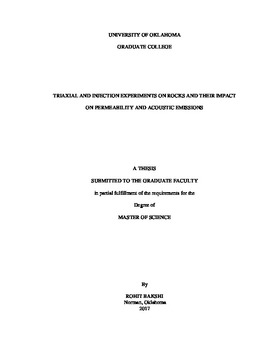| dc.description.abstract | Understanding the various micromechanical processes that occur in a rock under in-situ stress conditions has been a major imperative of rock mechanics. Some of the applications of rock mechanics include the science of earthquakes, improved recovery of energy from hydrocarbon and enhanced geothermal systems (EGS), civil and mining engineering to name a few. To obtain a comprehensive understanding of these micromechanical processes, triaxial experiments (heated and non –heated) have been performed while monitoring stress, strain, permeability alteration, wave velocity, and acoustic emissions. A variation of triaxial testing in which failure is caused by increasing the pore pressure of the sample during triaxial loading has also been carried out and studied. A range of rocks with a wide distribution of properties has been tested for this purpose – this includes sandstone, shale, rhyolite, rhyolitic tuff, basalt, limestones and granite. The reservoir rocks were also characterized using mineralogical and pore structure (SEM and thin sections) analysis.
Permeability of is an important rock property, and in this work, rock permeability variation has been studied during triaxial compression tests for a number of tuffs and basalts from potential EGS sites. Correlations have been found which link the change in permeability after failure to the rock’s initial porosity. It has been shown that axial permeability reduces for high porosity samples while it increases for low porosity samples after triaxial loading. Using the data for a range of rocks a porosity cut-off value for transition from decrease to increase of permeability has been proposed. Porosity of all samples was also measured and has been provided – in most cases the influence of confining pressure has also been provided.
In addition, Acoustic emission (AE) generation has monitored during the failure process and at various stages of triaxial deformation. Depending upon rock type, high or low AE activity has been observed. It has been observed that sandstones, granites and basalts generate high AE while limestone while certain types of tuffs rich in clay minerals do not generate much AE activity. Rocks that display ductile failure do not generate high acoustic emissions while brittle failure almost always does. In this study, ductile tuff samples generated less than 10 events up to failure whereas brittle samples from the same well generated greater than 1000 events.
The AE events were located to better depict areas of high AE activity within the samples. Higher AE activity was always observed in the fractured area and zones closer to the fracture. In addition to the above temporal and spatial analysis, Moment tensor analysis has also been performed using two techniques –one simplistic based on first wave arrival and the second with full tensor inversion with the primary aim of understanding emission source type – shear, tensile or mixed. Results show that both techniques only slightly differ from each other. Energy released during fracturing, amplitude of events and their frequency has also been studied for the rocks tested. The results show that maximum energy release happens during fracturing and a range of frequencies are generated during fracturing with no specific frequency tied to fracturing process.
Using the strain, stress, permeability, wave velocity and AE data sets, the micromechanical processes which usually culminate into the shear fracture has been illustrated for the rocks tested. In relation to permeability change, pore collapse and micro-cracking compete with each other during loading and depending upon the rock porosity, the final permeability may be higher or lower. It has been argued in this thesis that the above kind of analysis – combining several methods of data monitoring including stress, strain, wave velocities, permeability, mineralogical, pore structure and acoustic emission analysis with moment tensor inversion is a powerful tool for elucidating the micromechanical or macromechanical evolution of damage, during the deformation of rock.
Overall it has been shown here that in a triaxial test, permeability alteration within a rock is strongly linked to rock porosity and the event of largest change in permeability always coincides with a major release of AE. It has also been shown that volumetric strain determines the changes in permeability more strongly than any other parameter.
The triaxial-injection tests were completed successfully for a range of rocks. The results show that there are differences in results obtained while using this test instead of the standard triaxial test. Several high temperature tests were also performed and associated parameters calculated -it has been concluded that temperatures higher than 100 OC are needed for observing changes in elastic properties as compared to room temperature testing. | en_US |
| dc.subject | Geomechanics, Permeability, Acoustic emissions, triaxial testing, High temperature rock tests, EGS, Basalt testing, GEO-N2, INEL-1, Permeability under triaxial conditions, | en_US |
